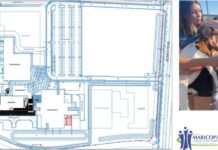Maricopa now has a blueprint for its future. Wednesday evening the City Council voted to approve the city’s first General Plan, with several additions and amendments. The long-range, comprehensive vision of what Maricopa can, and hopefully will, become now goes to the electorate for approval on the May 16, 2006, ballot.
The General Plan itself incorporates five areas of community planning, including Land Use, Circulation, Economic Development, Parks and Open Spaces and Public Services and Facilities. “The plan had an advisory team and a citizens’ advisory committee for grassroots level input,” according to city consultant David Williams, who was hired in December 2004 in order to implement a public participation program and to prepare the plan.
Additionally the plan has weathered a 60-day review period, beginning in September and ending on November 12, after which it was refined and updated in preparation for the December 21, 2005, Planning and Zoning Commission Public Hearing. Commissioners on that date unanimously recommended adoption of the plan, with several modifications to staff recommendations, including that the Future Land Use map remain unchanged at this time.

The General Plan’s future land use map.
“The public hearing tonight concludes the public participation element of the plan,” explained Williams. “The General Plan represents over a year of work and input from all different interest groups.” Those various interests were represented in a series of themed public workshops held in March, April and May of 2005.
Williams reminded the council and the audience that the General Plan is “not a factual statement but all about how you wish Maricopa to be perceived.” The ten-year planning vision must be readopted, according to state law, in ten years. Williams added, “I suggest to you that you’ll be doing that in three to five years.”
Asked whether the plan was too strict or not strict enough, Williams responded, “The General Plan is a broad overview of policy; the intent is to try to bring other, more specific plans into alignment. ” He explained that it is policy, not an ordinance, so the council and staff need to interpret it.

Consultant David Williams fields questiions from the council regarding the General Plan.
By state law major amendments can be made to the plan only once per year. Specific issues calling for amendment might include land use changes of at least 40 acres or a major infrastructure project without funding. “You don’t want to amend it too many times, or you lose the sense of the plan,” added Williams.
“Are roadway systems a trigger for major amendments?” asked Edward Farrell.
Williams advised that there are some facilities that are in use and some will be created. “Be flexible; put in less detail so changes don’t have to be made that trigger amendments,” he advised.
Mayor Kelly Anderson asked about needed updates to the plan. “There is a trend to do that administratively,” explained Williams, but you can involve the commission and council. Remember, this is a living document; it is not set in stone.”
Among the issues brought forth during the public hearing were developers’ concerns regarding a density formula in the General Plan. That calculation will be left to the zoning code and not included in the plan; however, it will be imperative that all developers calculate density the same way. In addition, a paragraph was added, stating, “developers should ensure that the expansion of public facilities is adequate to maintain quality service levels.” Such facilities would include drainage, parks and open spaces, utility services and safety services.
The Future Land Use map was to be left as stated in the General Plan. Larry Miller of Larry Miller Holdings offered to construct an overpass at Green Road through to the Gila River Indian Community in exchange for deleting some employment land use and adding residential use. “We have quite a history of putting infrastructure at the front end and making it look good,” explained Miller. After a lengthy discussion, Miller agreed to lessen the employment area, stating that he thought the overpass could be built for about $12 million.

Larry Miller (standing at left) of Miller Holdings discusses his land use proposal with staff while members of the council look on.
“I’m a big supporter of keeping employment, but this is a big cookie,” stated Will Dunn.
Vice-Mayor Brent Murphree cited the recent fatalities on SR 347 and the resulting traffic problems. “Only 2% of people know that you can go three miles one way or four miles the other way. We need to act on these public safety issues now. Frankly, this is our straw; we need to jump on it.”
“I think working with this will benefit the city in the long run,” added Steve Baker.
A legal representative from Volkswagen also spoke regarding future land use change designations. He stated that the plant was not being sold at this time and was “essentially taking a few steps back.” The plant may, in the future, seek a change in employment to employment with special designation usage, which could be accomplished through ordinance. City Manager Rick Buss noted that a change in the 1,600 acres currently designated employment might be a good use for a major amendment to the General Plan.
Council’s unanimous adoption of the General Plan, with strategic changes, goes to the voters in May for their approval. Within 90 days of the electorate’s approval, staff would come up with a full-blown strategic plan for implementation.
Maricopa’s blueprint for the future, its goals and land development policies are in place. All that remains is the approval of the citizenry, who provided the input for those same goals and objectives.
















